The Costs of Managing Insects in Soybeans
 |
Kevin L. SteffeyProfessor and Extension Specialist in Entomology Department of Crop SciencesPhone: (217) 333-6652 E-mail: ksteffey@illinois.edu |
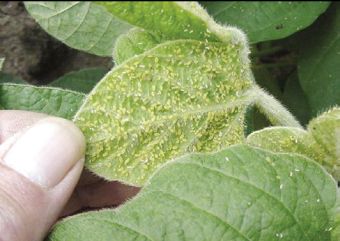
Figure 1 –Soybean aphids on the underside of a soybean leaflet. (Photo courtesy of Gray Bretthauer, Kendall County)
The discovery of soybean aphids in the United States in 2000 changed the way we perceive and practice soybean insect management (Figure 1). Many producers and agribusiness professionals have responded to the threat of soybean aphids in much the same manner that people have responded to the threat of corn rootworms in corn. To produce a crop for which insect control costs were mostly insignificant in the 20th Century, many producers now expect to spend money annually for insect control. Persistent concerns about bean leaf beetles and Japanese beetles and occasional concerns about twospotted spider mites contribute additional anxiety to the unpredictable nature of insect management in soybeans. Consequently, many soybean producers seek prophylactic solutions or enact kneejerk responses to anticipated insect (or mite) threats. So maybe it's time to examine the costs of managing insects in soybeans. (Author's note: Although twospotted spider mites are not insects, I imply both insects and mites when I use the word insects in this paper.)
As an entomologist who advocates the principles and practices of integrated pest management (IPM), I use the word "costs" to denote both economic and ecological costs. Economic costs are readily appreciated by soybean producers and have immediate significance. In contrast, ecological costs often are conceptual and indistinct and not seem to have immediacy. However, disruptions in the agricultural ecosystem almost always have economic consequences. Also, although we usually discuss pest management by subject matter and by pest species, pest control and crop production activities are interrelated, so action against one pest may result in direct or indirect consequences from another pest. In this paper, I address both economic and ecological costs of managing soybean insects.
The Economics of Managing Soybean Insects
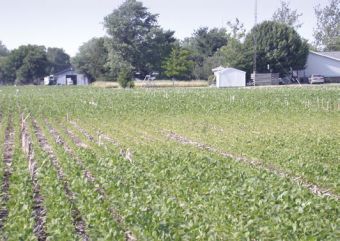
Figure 2 –Symptoms from an infestation of twospotted spider mites in soybeans, Champaign County, Illinois, 2005.
Before 2000, the cost of applying an insecticide for controlling insects in soybeans in Illinois was a variable cost that could not be foreseen from year to year. The insect of greatest concern was the bean leaf beetle. Soybean producers were aware that bean leaf beetles could threaten soybean production every year, so we were always "prepared" for them. In reality, however, bean leaf beetles only occasionally caused economic yield losses. Other occasional insect pests were grasshoppers, green cloverworms, and Japanese beetles. Localized outbreaks blister beetles, cutworms, painted lady caterpillars, potato leafhoppers, soybean thrips, and woollybear caterpillars occurred infrequently. Drought-induced outbreaks of twospotted spider mites always loomed as a threat, but such outbreaks have been relatively few and far between (Figure 2). In most years, farmers were able to produce a crop of soybeans without spending a dime on insect management.
The mostly spontaneous approach to soybean insect management began to change in 2000 when soybean aphids were discovered in North America. At about the same time, concern about bean leaf beetles transmitting bean pod mottle virus was mounting, impelled primarily by the situation in Iowa. Insecticides were applied to control bean leaf beetles in a lot of acres of soybeans in 2000, and even more acres were treated in 2001 to control soybean aphids. The widespread outbreak of economically damaging populations of soybean aphids in 2003 solidified the concerns of soybean producers throughout most of Illinois, significantly altering our perception of soybean insect management.
As our concerns about soybean insect pests were escalating, seed-applied insecticides were being developed for soybeans. Recent federal and state registrations of the active ingredients (a.i.) thiamethoxam (a.i. of Cruiser) and imidacloprid (a.i. of Gaucho) for application to soybean seed have generated considerable interest among soybean producers. Intended targets of both seed-applied insecticides are bean leaf beetles and soybean aphids. With these products and an assortment of organophosphate (e.g., Dimethoate, Lorsban) and pyrethroid (e.g., Asana, Baythroid, Mustang Max, Proaxis, Warrior) insecticide, soybean producers have a well stocked "chemical tool box" for insect control. The question of economics is, "Will the use of these tools provide a reasonable return on investment?"
The cost of an insecticide is relatively low when compared with other variable costs associated with soybean prodcution. However, as Schnitkey and Lattz state in their paper ("Managing Given Higher Corn and Soybean Costs") in this proceedings booklet, "Variable costs have increased dramatically over the past several years . . . Variable costs for soybeans are projected to be $20 per acre higher in 2006 when compared with costs in 2002." Therefore, any potential added cost of producing soybeans should be examined carefully for its return on investment.
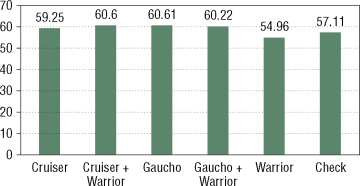
Figure 3 –Yields (bushels per acre) of soybeans treated with seed-applied and foliar-applied insecticides to control soybean aphids, Whiteside County, Illinois, 2005.
The simplest form of economics for insect control suggests that a return on investment is obtained when the yield benefit (i.e., prevention of yield loss) equals or exceeds the cost of the investment. Estimates of the per-acre costs of CruiserMaxx Pak (which includes both Cruiser and the fungicide ApronMaxx) are $10 for soybeans planted in 30-inch rows, $12 to $13 for soybeans planted in 15-inch rows, and $14 to $15 for drilled soybeans. Estimated costs of foliar-applied insecticides (plus application cost) range from about $9.50 to $13.50 per acre, depending upon the insecticide and rate applied and the cost of application (by ground or aerially). (I used prices for CruiserMaxx Pak, Dimethoate 400, Lorsban 4E, and Warrior provided by a two retailers and per-acre application costs of $4.50 to $6.50 per acre.) At a value of $5.25 per bushel of soybeans, a producer needs to protect about two to three bushels of soybeans per acre to obtain a return on investment in an insecticide. Changes in the value of soybeans or the cost of insecticide would affect this outcome. For example, if the value of soybeans declined or the cost of insecticide increased, a soybean producer would have to protect more bushels of soybeans from insect damage to obtain a return on investment.
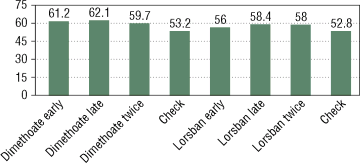
Figure 4 –Yields (bushels per acre) of soybeans treated with miticides to control twospotted spider mites, Champaign, Illinois, 2005.
These simplistic economics suggest that the expense of using an insecticide (either seed- or foliar-applied) once is a reasonable investment if an insect pest threatens soybean yields. In other words, application of an insecticide in response to an insect threat should provide a return on investment. However, we have no reasonable assurance that multiple applications (e.g., a seed-applied insecticide plus a foliar-applied insecticide, or more than one application of a foliar-applied insecticide) will provide the same level of return (Figures 3 and 4). Furthermore, there is no guaranteed return on investment if an insecticide is used to prevent insect injury that does not materialize.
The Ecological Costs of Managing Soybean Insects
The economic costs discussed in the previous section are understandable and relatively straightforward. In contrast, the ecological and environmental costs of using insecticides are very difficult to quantify. Furthermore, the ecological costs of herbicide or fungicide applications that may have indirect effects on insect management are even more difficult to quantify. However, any decision to use a pesticide should be informed by knowledge of both benefits and drawbacks. Additionally, the decision to use a pesticide should not be made in isolation from other crop production decisions. To ignore the cautions associated with pesticide use is to invite near-term or long-term misfortunes, which could include significant economic losses.
The soybean ecosystem is relatively simple when compared with more diverse ecosystems such as forests, prairies, and wetlands. If weeds are controlled in a soybean field, only one plant species remains. However, despite its relative simplicity, the soybean ecosystem harbors many species of organisms, many of which interact. Activities or products that affect one or more of these organisms might produce unintended effects on other organisms, resulting in unforeseen setbacks in pest management.
Everyone knowledgeable about IPM principles understands that two of the negative consequences (ecological costs) of overuse of insecticides are 1) development of insects resistant to insecticides and 2) destruction of natural enemies (i.e., predators, parasitoids, and pathogens) that regulate insect pest populations. Insecticide drift and misuse may also have negative environmental consequences. In this paper, however, I focus only on the ecological costs of insecticide use.
Resistance to Insecticides
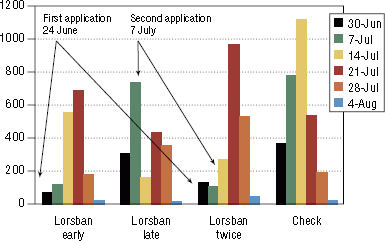
Figure 5 –Densities of twospotted spider mites (mites per 5 leaflets) on soybeans treated with Lorsban 4E, Champaign County, Illinois, 2005.
Use of insecticides to control soybean aphids has been relatively widespread in several of the north central states over the past five years, especially in 2003 and 2005. Millions of acres have been sprayed, especially in Michigan, Minnesota, and Wisconsin, but also in Illinois, Indiana, and Iowa. The insecticides applied—primarily pyrethroids—place tremendous selection pressure on soybean aphid populations, so the threat of the aphids becoming resistant to one or more insecticides is real. Many other insects present in soybean fields also are exposed to insecticides applied to control soybean aphids. Some of these non-targeted pests (e.g., twospotted spider mite, western corn rootworm) have a history of developing resistance to insecticides. In 2005, many soybean acres were treated with miticides to control twospotted spider mites, and some fields were treated more than once. Many people reported that the second and third applications did not seem to control the mites, and evidence from our experiment in Champaign County in 2005 substantiate those observations (Figure 5). Although the development of soybean pest populations in Illinois that are resistant to our modern insecticides has not been documented, continued widespread use of insecticides in soybeans will keep the concern front and center.
Destruction of Natural Enemies
This facet of soybean ecology has become rather complex, with multiple interactions among pests, natural enemies, and pesticides. The simplest recommendation is to avoid applying insecticides to insect populations before their densities reach an established economic threshold. This is particularly important advice for pests that have significant reproductive potential, e.g., soybean aphid, twospotted spider mite. However, some people have begun the practice of tank-mixing an insecticide with Roundup applied in June to prevent the buildup of soybean aphid populations, well before densities of aphids reach the current economic threshold of 250 aphids per plant. This practice could have multiple ramifications.
First, application of insecticides to soybeans in June may significantly reduce or eliminate populations of the insidious flower bug, Orius insidiosus, a predator known to suppress early season populations of soybean aphids. Populations of the multicolored Asian lady beetle, the most important predator of soybean aphids, also may be reduced or eliminated. If soybean aphids re-colonize the treated field in the absence of predators later in the summer, aphid densities could "explode," requiring yet another insecticide application. This type of "pesticide treadmill" is a recipe for serious problems.
Second, application of insecticides to soybeans in June also may eliminate natural enemies of other soybean pests (e.g., predatory mites that prey on twospotted spider mites), enabling the non-target pest to threaten soybean yield. For the most part, pyrethroids are ineffective against twospotted spider mites, so the application of pyrethroids in June may "flare" spider mite populations.
Third, and not widely realized, some formulations of Roundup herbicide have fungicidal properties. Researchers at Iowa State University revealed that some formulations of Roundup reduced the incidence of Neozygites floridana, a fungal pathogen that regulates populations of twospotted spider mites. So, a tank-mix of Roundup and a pyrethroid insecticide may eliminate all or most of the natural enemies that keep spider mites in check, allowing the spider mites to thrive.
Finally, some research recently conducted at the University of Minnesota suggests that fungicides delayed onset and suppressed the prevalence of entomopathogenic fungi that regulate populations of soybean aphids. The researchers suggested a relationship between suppression of entomopathogenic fungi and survival of overwintering soybean aphids.
The Costs of Managing Insects in Soybeans
As explained, economics are not the only costs associated with managing insects in soybeans. Soybean producers must protect their crop from economic losses caused by insects, especially in the midst of an insect outbreak. However, the ecological costs of indiscriminate use of pesticides must be taken seriously. Although there is little evidence that widespread use of insecticides, herbicides, and fungicides is disrupting the soybean ecosystem, the potential should not be ignored. Given all of the known and feasible interrelationships among organisms in a soybean field, a lack of restraint in pesticide use could have a domino effect with long-term consequences.